 While in Corning, we stopped at the Corning Museum of Glass.
While in Corning, we stopped at the Corning Museum of Glass. We were not there for very long, but what we did see was great. We loved this:
We were not there for very long, but what we did see was great. We loved this: 


There's somebody out there for everybody. You just have to wait for god to bring them into your life.
 While in Corning, we stopped at the Corning Museum of Glass.
While in Corning, we stopped at the Corning Museum of Glass. We were not there for very long, but what we did see was great. We loved this:
We were not there for very long, but what we did see was great. We loved this: 



 They shared Nathan's second cake with us. We ate fajitas for dinner. We played pickleball. It was a great day.
They shared Nathan's second cake with us. We ate fajitas for dinner. We played pickleball. It was a great day.
 Not sure if this is just an individual store deal (Fort Wayne) or nationwide but I just got a really good deal on storage totes at Staples. They have them online at $16.49 each, however, I just purchased several of them today in-store for $7.99 each! And may purchase more when I go back to Fort Wayne on Friday. Hopefully they will still have them and at the sale price. Oddly enough, I think the "everyday" in-store price was $14.49 though I can't imagine why they would cost $2 more if purchased online.
Not sure if this is just an individual store deal (Fort Wayne) or nationwide but I just got a really good deal on storage totes at Staples. They have them online at $16.49 each, however, I just purchased several of them today in-store for $7.99 each! And may purchase more when I go back to Fort Wayne on Friday. Hopefully they will still have them and at the sale price. Oddly enough, I think the "everyday" in-store price was $14.49 though I can't imagine why they would cost $2 more if purchased online.

 Angels Landing from the beginning of the West Rim Trail. Scout's Lookout is in the foreground (that flat, sandy area). The trail ascends that small peak on its west side then climbs up the ridge of the second peak.
Angels Landing from the beginning of the West Rim Trail. Scout's Lookout is in the foreground (that flat, sandy area). The trail ascends that small peak on its west side then climbs up the ridge of the second peak. A full view of the east side of Angels Landing showing the 1200 foot sheer drop to the Virgin River flowing through the valley below.
A full view of the east side of Angels Landing showing the 1200 foot sheer drop to the Virgin River flowing through the valley below. I followed the West Rim Trail for about an hour when it took a decided turn towards the North. I looked behind me and saw an unmarked trail through the sand leading to a section of slick rock. Venturing off the trail I followed the slick rock to it's end, about half an hour or so. (Photo was taken on my way back, hence the change in lighting.)
I followed the West Rim Trail for about an hour when it took a decided turn towards the North. I looked behind me and saw an unmarked trail through the sand leading to a section of slick rock. Venturing off the trail I followed the slick rock to it's end, about half an hour or so. (Photo was taken on my way back, hence the change in lighting.) There below me was the scene I was seeking. Walter's Wiggles and Angels Landing. I spent several hours just sitting there at the edge, looking down. It was a wonderful spot to have lunch!
There below me was the scene I was seeking. Walter's Wiggles and Angels Landing. I spent several hours just sitting there at the edge, looking down. It was a wonderful spot to have lunch! By mid-afternoon, the sun had almost disappeared, clouds had moved in and the wind had picked up considerably. Reluctantly, I left my perch on the side of the canyon.
By mid-afternoon, the sun had almost disappeared, clouds had moved in and the wind had picked up considerably. Reluctantly, I left my perch on the side of the canyon. Walter's Wiggles from the first vantage point.
Walter's Wiggles from the first vantage point. And from the second viewpoint.
And from the second viewpoint. In this close up image of the upper route, green dots represent the high camps and bivies and the blue sections represent areas of difficulty or belays. It's interesting to note that the team took the far right variation out of Thumb Rock.
In this close up image of the upper route, green dots represent the high camps and bivies and the blue sections represent areas of difficulty or belays. It's interesting to note that the team took the far right variation out of Thumb Rock. "As soon as we started to set up camp, my body started to let me know exactly what I had done to it... I threw up before I got in the tent, and... three more times before I could get some Power Gels and water to stay down. I didn't have a headache and I was not concerned it was AMS. The weather was not perfect and when we woke up at 0500. I said I could use another day to recover. They all agreed a rest day was in order so we stayed in the tent all day long."After a recovery, the team climbed a major porition of the upper route. The 5th night was pitched at a bivy site above 13,000 feet. At that camp, Issac described setting anchors into the rock for fear of either being blown or avalanched off the mountain. Thankfully, neither happened.
 Watch your head!
Watch your head!

 After the tour we panned for gold and even founda few flakes!
After the tour we panned for gold and even founda few flakes! Getting warm again - so back underground to Rushmore Cave. This is the original natural entrance.
Getting warm again - so back underground to Rushmore Cave. This is the original natural entrance. It is filled with natural limestone formations
It is filled with natural limestone formations Lots of narrow winding tunnels and ups and downs. Could've used the hard hat in here too.
Lots of narrow winding tunnels and ups and downs. Could've used the hard hat in here too. The "Big Room"
The "Big Room" Lots of Stalactites
Lots of Stalactites We got free admission with our VIP Pass and they told us the zip line ride was free as well. Since we were well chilled from the hour tour we didn't mind waiting in line in the hot sun.
We got free admission with our VIP Pass and they told us the zip line ride was free as well. Since we were well chilled from the hour tour we didn't mind waiting in line in the hot sun.


 Time to head home, we take the Iron Mountain Road with the Pigtail Bridges- you drive under the bridge and then the road circles around so you cross the bridge
Time to head home, we take the Iron Mountain Road with the Pigtail Bridges- you drive under the bridge and then the road circles around so you cross the bridge As we were driving home we passed the Black Hills Playhouse. They do a practice run of a play on the Wednesday before opening and VIP pass holders get in free. We hadn't had a chance to do one yet, we were either working or had forgotten about it or last week when we remembered it was an off week. I had it in my mind that it was next week but I noticed cars in the lot as we drove by and decided to check my "cheat sheet" and sure enough it was this evening so we did a U-Turn and headed back
As we were driving home we passed the Black Hills Playhouse. They do a practice run of a play on the Wednesday before opening and VIP pass holders get in free. We hadn't had a chance to do one yet, we were either working or had forgotten about it or last week when we remembered it was an off week. I had it in my mind that it was next week but I noticed cars in the lot as we drove by and decided to check my "cheat sheet" and sure enough it was this evening so we did a U-Turn and headed back
 We ended up seeing "All Shook Up" a musical comedy with a lot of Elvis music and comical situations of mistaken identity. The Set wasn't complete and it was the first time the cast had performed in front of a live audience. They only had 5 days of rehearsals. They did quite well and we enjoyed the performance.
We ended up seeing "All Shook Up" a musical comedy with a lot of Elvis music and comical situations of mistaken identity. The Set wasn't complete and it was the first time the cast had performed in front of a live audience. They only had 5 days of rehearsals. They did quite well and we enjoyed the performance. On Friday May 14, the U.S. Senate unanimously passed Resolution 526, which honors the men and women who perform Search and Rescue (SAR) throughout the United States. The Resolution specifically acknowledges the role that professionals and volunteers provide to our country, and sets aside the week of May 16 to May 22, as National Search and Rescue week. Also, it encourages the people of the United States to observe and hold ceremonies and activities that promote awareness and appreciation of the role SAR personnel provide for their communities.
On Friday May 14, the U.S. Senate unanimously passed Resolution 526, which honors the men and women who perform Search and Rescue (SAR) throughout the United States. The Resolution specifically acknowledges the role that professionals and volunteers provide to our country, and sets aside the week of May 16 to May 22, as National Search and Rescue week. Also, it encourages the people of the United States to observe and hold ceremonies and activities that promote awareness and appreciation of the role SAR personnel provide for their communities.



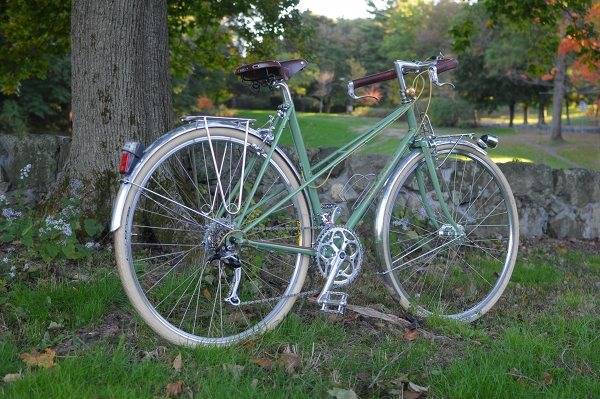 Trying to write a definitive post about the completion of my custom mixte (whom I have named "Constance") has been overwhelming, but I am forcing myself to do itbefore too much time goes by. Perhaps it will help if I try to cut down on the sappy stuff and just write about it briefly, matter-of-factly. After all, it's just a bike forgoddsake... Right!
Trying to write a definitive post about the completion of my custom mixte (whom I have named "Constance") has been overwhelming, but I am forcing myself to do itbefore too much time goes by. Perhaps it will help if I try to cut down on the sappy stuff and just write about it briefly, matter-of-factly. After all, it's just a bike forgoddsake... Right!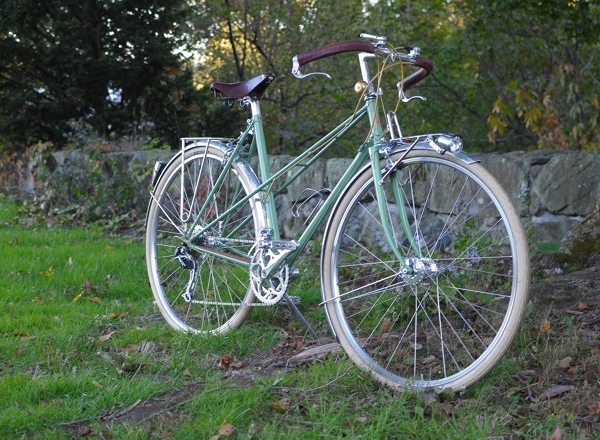 In September of last year I met Bryan Hollingsworth, who is the framebuilder behind Royal H. Cycles, and asked him to make me a custom mixte frame in the tradition of theFrench constructeurs. The frame was finished on my birthday this February. One by one, I purchased all the components, and the Co-Habitant and I put the bike together at the end of the summer. The bicycle was complete in September , about a year after its inception. If you are interested in the step by step details of the process, you can read all about it by scrolling through these posts; they document the bike from the initial stages of frame design to tweaking the component choices.
In September of last year I met Bryan Hollingsworth, who is the framebuilder behind Royal H. Cycles, and asked him to make me a custom mixte frame in the tradition of theFrench constructeurs. The frame was finished on my birthday this February. One by one, I purchased all the components, and the Co-Habitant and I put the bike together at the end of the summer. The bicycle was complete in September , about a year after its inception. If you are interested in the step by step details of the process, you can read all about it by scrolling through these posts; they document the bike from the initial stages of frame design to tweaking the component choices. To start with a basic description of the bicycle, it is a classic, fully lugged mixte frame with twin lateral stays.The tubing is eclectic, designed with comfort and strength as the main priorities: The downtube and seat stays areColumbus. The seat tube isNova. The chainstays areVitus. And the twin stays are domestic 4130 straight gauge.
To start with a basic description of the bicycle, it is a classic, fully lugged mixte frame with twin lateral stays.The tubing is eclectic, designed with comfort and strength as the main priorities: The downtube and seat stays areColumbus. The seat tube isNova. The chainstays areVitus. And the twin stays are domestic 4130 straight gauge.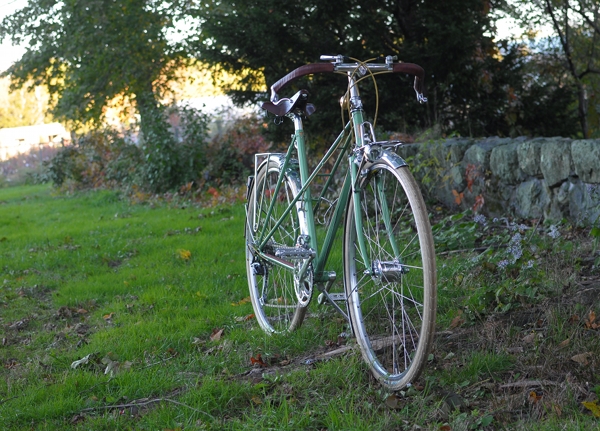 The 52cm frame has a 54cm virtual top tube, 73°seat tube angle, 72°head tube angle, 53mmfork rake, 54.5mm trail, and 430mm chainstays.
The 52cm frame has a 54cm virtual top tube, 73°seat tube angle, 72°head tube angle, 53mmfork rake, 54.5mm trail, and 430mm chainstays. The liquid paint and lug outlining were done byCircle A Cyclesin Providence, RI.
The liquid paint and lug outlining were done byCircle A Cyclesin Providence, RI. The "dusty mint" colour was matched to a swatch I provided. The Royal H. insignia and lug outlining were done in copper.
The "dusty mint" colour was matched to a swatch I provided. The Royal H. insignia and lug outlining were done in copper. As far as construction goes, several neat features make the bicycle special. To start with, it is nearly impossible to have a fully lugged mixte built nowadays, because the twin headtube lugs are no longer made. These were procured new old stock.
As far as construction goes, several neat features make the bicycle special. To start with, it is nearly impossible to have a fully lugged mixte built nowadays, because the twin headtube lugs are no longer made. These were procured new old stock. The "bullet" style seat stay caps were the framebuilder's idea and I was not sure I wanted them at first, but they look spectacular.
The "bullet" style seat stay caps were the framebuilder's idea and I was not sure I wanted them at first, but they look spectacular. The flat-top fork crown has a small custom embellishment, and notice the little lugged braze-on for the shifter boss. I should mention that this bicycle has clearances for 35mm+ tires plus fenders...
The flat-top fork crown has a small custom embellishment, and notice the little lugged braze-on for the shifter boss. I should mention that this bicycle has clearances for 35mm+ tires plus fenders... Everything that could possibly be lugged on this mixte, is!
Everything that could possibly be lugged on this mixte, is! - including these amazing triple sockets on the rear dropouts. Read more about them, and other aspects of the lugwork here(not to mention the custom stainless steel kickstand plate!).
- including these amazing triple sockets on the rear dropouts. Read more about them, and other aspects of the lugwork here(not to mention the custom stainless steel kickstand plate!). There are braze-ons for both front and rear racks, and the bicycle was built to accommodate reasonable front and rear loads.
There are braze-ons for both front and rear racks, and the bicycle was built to accommodate reasonable front and rear loads.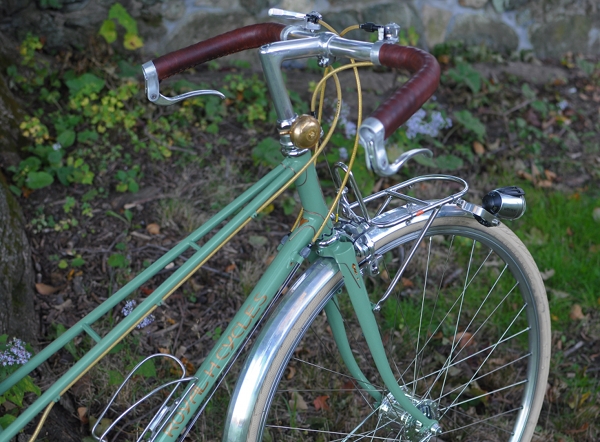 If you are interested in a full technical description of the components, you can find thathere. But for those who just want the main points of interest, I will describe a few.
If you are interested in a full technical description of the components, you can find thathere. But for those who just want the main points of interest, I will describe a few.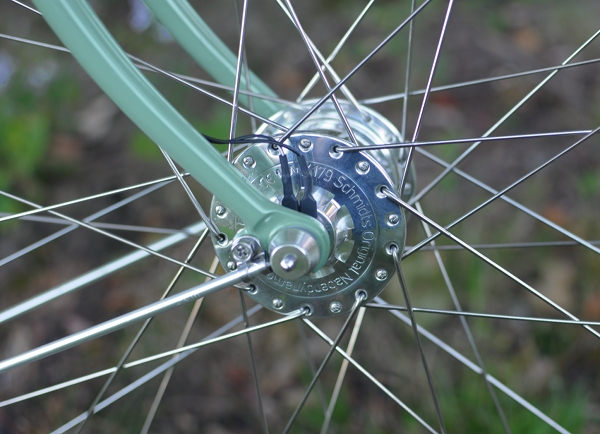 The 700C wheels were built by Peter White, with a Schmidt SON dynohub to power the lights. The headlight and tail light are the same as on my Rivendell, and you can read about them here.
The 700C wheels were built by Peter White, with a Schmidt SON dynohub to power the lights. The headlight and tail light are the same as on my Rivendell, and you can read about them here. Braze-ons along the inside of the fork accommodate the wiring for the headlight.
Braze-ons along the inside of the fork accommodate the wiring for the headlight.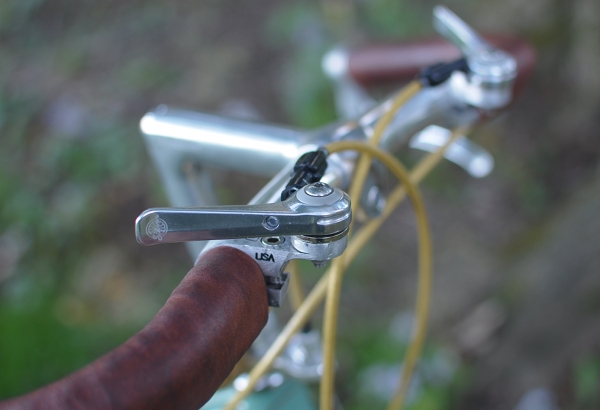 The handlebars are the Velo OrangePorteurbars, used with a 10mm stem, inverse brake levers, and Silver shifters inserted into Paul thumbies - which were heavily modified for the purpose.
The handlebars are the Velo OrangePorteurbars, used with a 10mm stem, inverse brake levers, and Silver shifters inserted into Paul thumbies - which were heavily modified for the purpose. The bicycle was built to accommodate centerpull brakes, as this is my preferred style of brakes. The brakes are Dia Compe centerpulls from VO - which function great, but had to be slightly modified to fit properly (which, as I understand, is a problem other have had as well).
The bicycle was built to accommodate centerpull brakes, as this is my preferred style of brakes. The brakes are Dia Compe centerpulls from VO - which function great, but had to be slightly modified to fit properly (which, as I understand, is a problem other have had as well). The crankset is a Sugino Alpina double. You can't tell in this picture, but there is a neat braze-on for the front derailleur.
The crankset is a Sugino Alpina double. You can't tell in this picture, but there is a neat braze-on for the front derailleur. The rear derailleur is the Shimano XT "Shadow". I love this derailleur, because it tucks in closely to the wheel, so that it is less likely to get dinged if you are riding off-road, or even if the bike gets slammed by a door. Given that I have nearly destroyed the rear derailleur on my Rivendell in half a year's time, I think the "Shadow" was made for me. Oh, and if you are wondering what that monstrous-looking cassette is, that is a Sheldon Brown custom touring cassette.Please be honest about this one: how bad does this look? I considered switching the biggest ring (currently a 34t) to a slightly smaller one, so that it blends in with the others visually - though over time the weirdness of it has grown on me.
The rear derailleur is the Shimano XT "Shadow". I love this derailleur, because it tucks in closely to the wheel, so that it is less likely to get dinged if you are riding off-road, or even if the bike gets slammed by a door. Given that I have nearly destroyed the rear derailleur on my Rivendell in half a year's time, I think the "Shadow" was made for me. Oh, and if you are wondering what that monstrous-looking cassette is, that is a Sheldon Brown custom touring cassette.Please be honest about this one: how bad does this look? I considered switching the biggest ring (currently a 34t) to a slightly smaller one, so that it blends in with the others visually - though over time the weirdness of it has grown on me. The bicycle is fitted with the beautiful Honjo"Le Paon" fenders (similar to the VO "Zeppelins" I have on my Rivendell, but shinier and somehow more elegant), and the front rack is a VO Randonneur.
The bicycle is fitted with the beautiful Honjo"Le Paon" fenders (similar to the VO "Zeppelins" I have on my Rivendell, but shinier and somehow more elegant), and the front rack is a VO Randonneur. The rear rack is a VO Constructeur, which is small but can nonetheless fit a standard Dutch-size pannier. Oh, and the tires are (big surprise!) Schwalbe Delta Cruisers, 700C x 35mm. And I think I will stop now with the components, before I put everybody to sleep! If you have questions after reading this post and the spec list here, please ask in the comments and I will be glad to answer.
The rear rack is a VO Constructeur, which is small but can nonetheless fit a standard Dutch-size pannier. Oh, and the tires are (big surprise!) Schwalbe Delta Cruisers, 700C x 35mm. And I think I will stop now with the components, before I put everybody to sleep! If you have questions after reading this post and the spec list here, please ask in the comments and I will be glad to answer.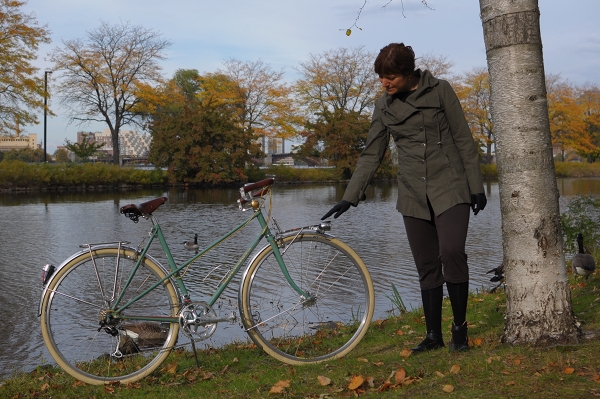 My impression of the mixte is multi-layered, but all the layers can be placed firmly in the category of "love". The bicycle handles differently than I had imagined, but only because I had no way of imagining something I had never experienced before. It is freakishly light, and luxuriously, almost abnormally comfortable while at the same time being faster and more responsive than any upright bicycle I have ridden before. It is more responsive than the vintage mixte, "Marianne," I used to own, which I had complained was "twitchy". Somehow, on the Royal H.the responsiveness does not feel scary; I can control it. No idea how this all works, but I am certainly happy about it.
My impression of the mixte is multi-layered, but all the layers can be placed firmly in the category of "love". The bicycle handles differently than I had imagined, but only because I had no way of imagining something I had never experienced before. It is freakishly light, and luxuriously, almost abnormally comfortable while at the same time being faster and more responsive than any upright bicycle I have ridden before. It is more responsive than the vintage mixte, "Marianne," I used to own, which I had complained was "twitchy". Somehow, on the Royal H.the responsiveness does not feel scary; I can control it. No idea how this all works, but I am certainly happy about it.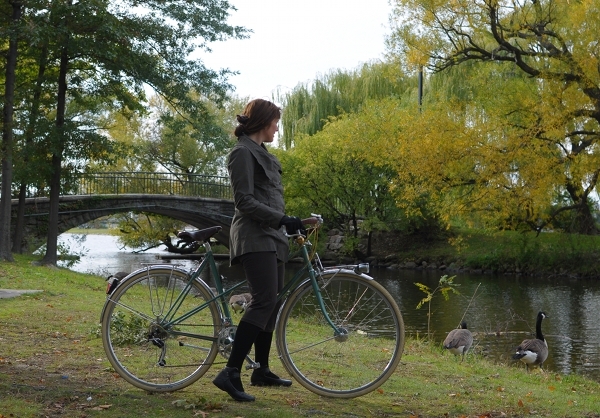 The fit of the mixte is just perfect for me, and I can feel that my proportions have been taken into consideration - everything just feels "right". The bicycle handles best with a 10cm stem, with the handlebars close to level with the saddle, and with the saddle pushed back a bit.
The fit of the mixte is just perfect for me, and I can feel that my proportions have been taken into consideration - everything just feels "right". The bicycle handles best with a 10cm stem, with the handlebars close to level with the saddle, and with the saddle pushed back a bit.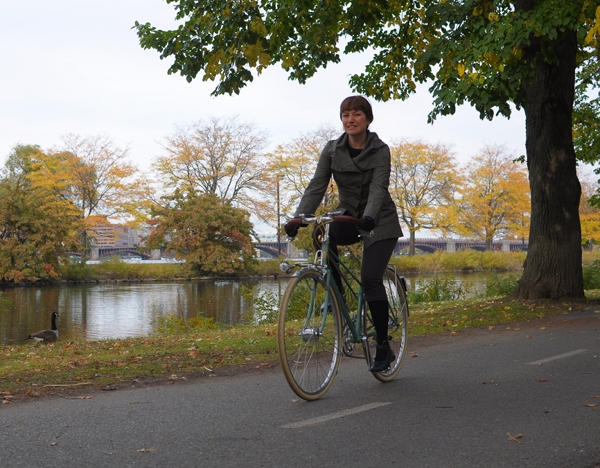 I have ridden the mixte all over town since early September, and have taken it on two longish rides (40 miles and 30 miles). Everything is beyond perfect and there is zero pain. I have tried to describe the ride quality here and here if you are interested in the details. One thing I love that I would never have expected to love, is the high bottom bracket. I feel almost majestically tall on this bicycle, even when leaned over and holding the front of the bars.
I have ridden the mixte all over town since early September, and have taken it on two longish rides (40 miles and 30 miles). Everything is beyond perfect and there is zero pain. I have tried to describe the ride quality here and here if you are interested in the details. One thing I love that I would never have expected to love, is the high bottom bracket. I feel almost majestically tall on this bicycle, even when leaned over and holding the front of the bars.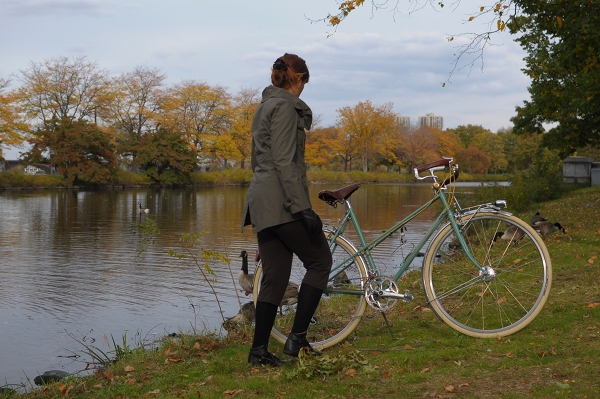 Given that this is a custom bicycle, I should probably conclude with a few words about the framebuilder. BryanHollingsworth is a young builder with considerable experience working for the world-famous Seven Cycles. He is a knowledgeable, enthusiastic, easy-going, and genuinely nice person. I knew that Bryan was the right builder for me, because he immediately understood the kind of bicycle I wanted, and got excited about building it. He was surprisingly pro-active about design solutions and pointed out possibilities that even my detail-obsessed imagination had not considered. As a result, my frame has some unique features that I cannot take any credit for what so ever; they were Bryan's idea! Additionally, now that I am actually riding the bicycle, it is clear that Bryan had put a lot of thought into making it comfortable for me, while, at the same time, giving it a degree of fiestiness that I had not expected.
Given that this is a custom bicycle, I should probably conclude with a few words about the framebuilder. BryanHollingsworth is a young builder with considerable experience working for the world-famous Seven Cycles. He is a knowledgeable, enthusiastic, easy-going, and genuinely nice person. I knew that Bryan was the right builder for me, because he immediately understood the kind of bicycle I wanted, and got excited about building it. He was surprisingly pro-active about design solutions and pointed out possibilities that even my detail-obsessed imagination had not considered. As a result, my frame has some unique features that I cannot take any credit for what so ever; they were Bryan's idea! Additionally, now that I am actually riding the bicycle, it is clear that Bryan had put a lot of thought into making it comfortable for me, while, at the same time, giving it a degree of fiestiness that I had not expected.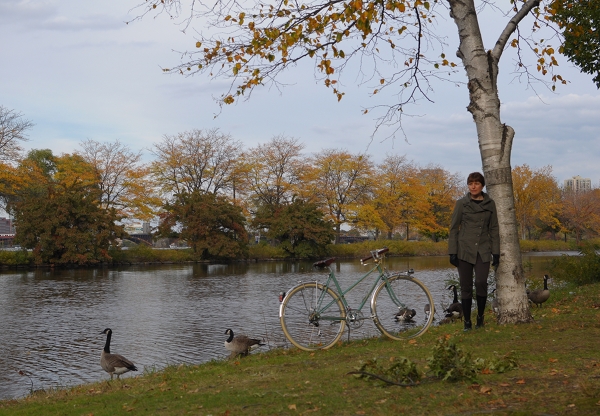 I will also address price and affordability, since some have already been asking about this. I would rather not disclose the cost of my frame - mainly because that figure will no longer be of use to anyone. When I met Bryan, he had only just begun building custom frames under his own name, and that is how I was able to afford the project. A year later, Royal H. has taken off like a rocket, and, naturally, the price structure has changed somewhat. As for affordability, my advice would be to find a frame builder you like, and then discuss the possibility of breaking up the payment into several installments. This makes paying for the frame considerably easier. Furthermore, no one says that you must buy all the components immediately, and all at once. I saved up for them gradually, which is why it took nearly a year for my bicycle to reach completion. And yes, it was worth it!
I will also address price and affordability, since some have already been asking about this. I would rather not disclose the cost of my frame - mainly because that figure will no longer be of use to anyone. When I met Bryan, he had only just begun building custom frames under his own name, and that is how I was able to afford the project. A year later, Royal H. has taken off like a rocket, and, naturally, the price structure has changed somewhat. As for affordability, my advice would be to find a frame builder you like, and then discuss the possibility of breaking up the payment into several installments. This makes paying for the frame considerably easier. Furthermore, no one says that you must buy all the components immediately, and all at once. I saved up for them gradually, which is why it took nearly a year for my bicycle to reach completion. And yes, it was worth it! I named this bicycle "Constance", because I hope she always remains in my life. Thank you to everyone who made my custom mixte possible, both directly and indirectly.
I named this bicycle "Constance", because I hope she always remains in my life. Thank you to everyone who made my custom mixte possible, both directly and indirectly.